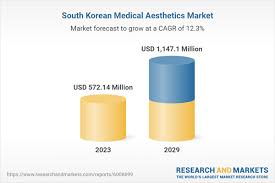South Korea is witnessing an extraordinary rise in medical tourism, particularly among English-speaking individuals. Fueled by government initiatives and the allure of advanced cosmetic procedures, this burgeoning sector caters to a diverse clientele, including Singaporeans and American media personalities. As the demand for aesthetic treatments soars, the landscape of tourism in South Korea is evolving rapidly.
The Medical Tourism Boom
South Korea’s medical aesthetics tourism industry is thriving thanks to significant government backing. With a target of attracting 700,000 foreign patients annually by 2027, the nation has exceeded expectations, hosting a record-breaking 1.17 million medical tourists last year, primarily for dermatological and plastic surgeries.
Prominent figures, such as media stars from the United States, are increasingly opting for aesthetic treatments, demonstrating the attractive services offered in South Korea. Many patients utilize beauty concierge services, acting as intermediaries that connect customers with healthcare providers. These concierges facilitate every aspect of the patient’s journey, from initial inquiries to post-operative care, all while providing essential translation services.
The Role of Beauty Concierges
Beauty concierges operate without charging their clients, earning commissions from affiliated medical facilities. Although such services are not a new phenomenon, they have recently started catering to a broader audience, particularly English-speaking tourists. The goal? To ensure a seamless experience in a highly competitive field.
Most medical tourists are from Asia, including Japan and China, which represent a significant share of the market. However, interest from the United States, while comparatively smaller at 8.7%, is growing, highlighting the increasing diversity in demographics seeking treatments in South Korea.
The Surge of English-Speaking Clients
With the English-speaking segment expanding, numerous beauty concierge services have sprouted to meet this demand. Entrepreneurs like Joyce Kang, who founded a concierge firm specifically catering to English speakers, have noted a significant uptick in clients. Her business has doubled since its inception in 2023, indicating the rapid growth within this niche market.
Clients from countries such as Australia, Canada, and particularly Singapore, are showing a keen interest in aesthetic treatments. Many of them are in their 20s and 30s, focusing on facial surgeries to achieve their desired looks. This demographic shift suggests that as younger generations become more involved in their appearances, the demand for medical tourism will likely continue to increase.
Market Dynamics
South Korea has been strategic in its approach to medical tourism, easing visa restrictions and offering tax refunds for plastic surgery procedures—tactics designed to attract foreign patients. The plethora of clinics competing for business, particularly in areas like Gangnam, fosters an environment where prices and services are aggressively marketed, often leading to patients experiencing overwhelm.
Concerns have arisen, however, regarding the legality of many concierge services. As the market becomes oversaturated, potential providers may operate unlawfully, posing risks to those seeking treatment abroad.
Future Prospects and Challenges
As the medical tourism sector continues to evolve, there remains significant room for growth. For instance, Cheryl Soh, a 26-year-old who recently traveled to Seoul for plastic surgery, reflects the intentions of many—seeking results that stay beyond regional boundaries. The interconnected nature of medical tourism also emphasizes that while patients are venturing abroad, they are still contributing to the overall medical tourism flow affecting destinations worldwide.
Despite the allure of South Korea’s advanced facilities, prospective patients, especially those from further afield, are typically more inclined to maximize their investments by planning multiple procedures within a single visit. As a result, longer stays encompassing various treatments are becoming commonplace.
Guidelines for Patients
With opportunities come responsibility. Patients are urged to conduct thorough research before embarking on their medical journey. It’s critical for individuals to have a clear understanding of the procedures they desire as aggressive marketing strategies can often lead to upselling unnecessary additions.
Post-operative care and the ambiance of medical facilities are of utmost importance as well. The presence of qualified translators and staff who understand the complexities of working with international clients is vital for achieving satisfactory outcomes.
Conclusion
The growth of medical tourism, particularly through English-speaking channels, is challenging traditional norms within the industry. South Korea’s attractive cosmetic offerings—combined with an efficient support system—place it at the forefront of this trending market. Given its increasing appeal, the demand for medical tourism is projected to rise, ultimately impacting how travelers perceive destinations. Exploring this domain reveals promising avenues for connecting healthcare with tourism aspirations.
For those curious about maritime pursuits in conjunction with such travel trends, GetBoat.com stands as an international marketplace offering various options for renting sailing boats and yachts, representing an ideal avenue to explore additional adventures alongside medical tourism.


